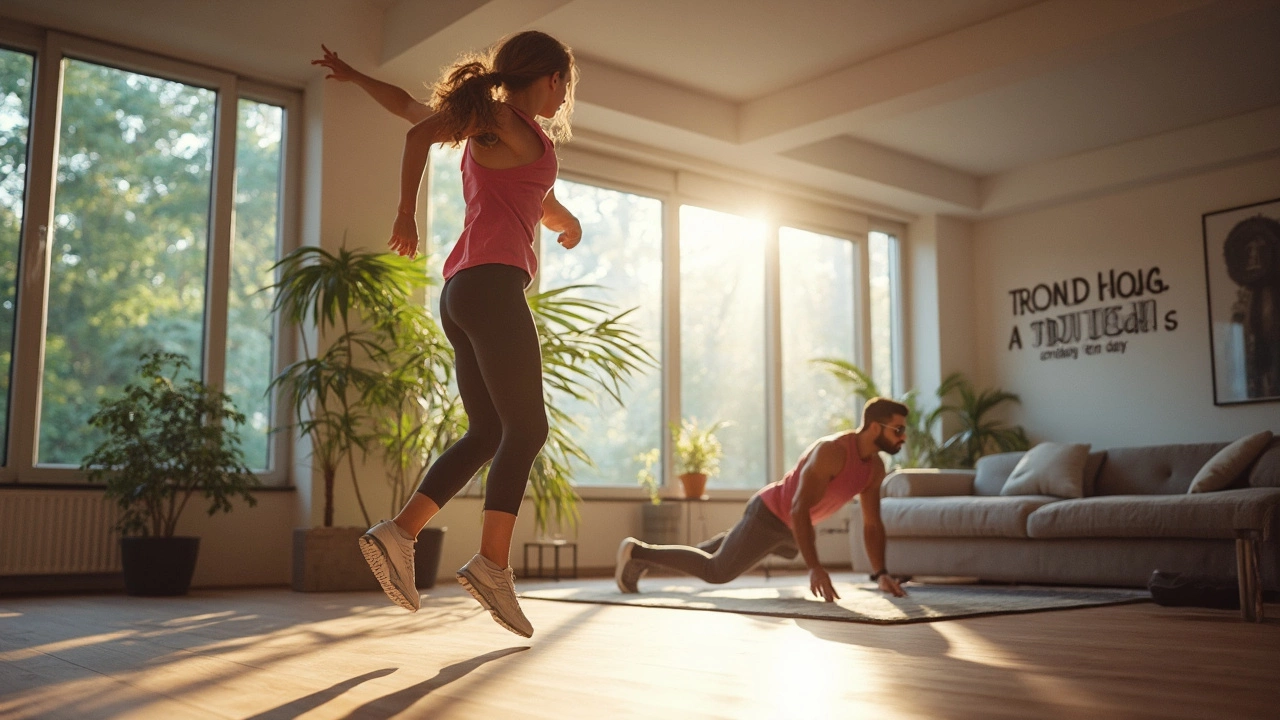How to Get Fit Fast at Home: Effective Home Workout Tips for Quick Results

Sliding into your jeans without a struggle or picking up groceries without feeling as if your arms are about to fall off—who doesn’t crave that feeling of being fit? Yet, the idea of joining a gym or investing in fancy equipment can feel exhausting before you even get started. Here’s a little-known truth: you can kickstart your fitness journey and see real changes quickly, right from your living room. You don’t need much—just a bit of space, a dash of motivation, and a plan that actually challenges you. The science backs it up—over 60% of adults who start exercising at home stick with their routine longer than those who go to the gym. If time is tight and motivation feels low, building your workout sanctuary at home could be your game-changer. Ready to get practical and see results, fast?
Why Quick Home Fitness Works
The biggest appeal of getting fit at home isn’t just convenience—it’s how shockingly effective it can be when done right. Your body doesn’t care about the setting; it cares about how you move it. Bodyweight exercises, HIIT workouts, and mini circuits all give you serious bang for your buck. Even a ten-minute micro-workout can boost your heart rate and metabolism, helping you burn more calories throughout the day.
There’s evidence everywhere: Harvard Health says that a brisk 30-minute home workout can burn about 225 calories—roughly the same as running at a moderate pace but with no treadmill required. The trick is to keep the pace lively, minimize breaks, and dial up the intensity just enough to break a sweat without hitting a wall. If you’re worried about losing progress because you’re skipping the gym, don’t be. Fitness influencers and trainers worldwide rave about their quick, do-anywhere routines for a reason—they simply work.
A home workout also keeps distractions at bay. No long commutes to the gym, no waiting for equipment, no self-conscious glances in the mirror. It’s just you and your goals. Plus, keeping your workout space within arm’s reach makes laziness less tempting. According to a 2023 report in the Journal of Behavioral Medicine, people who add home-based movement into their daily schedule have a 38% higher chance of hitting their fitness targets within one month compared to their gym-going counterparts.
If time is your biggest barrier, home fitness is the answer. Only have five minutes to spare between Zoom calls? Knock out a set of squats and push-ups. Doing laundry? Lunge across your hallway. That freedom is powerful. I’ve seen firsthand how my friends squeeze in squats before coffee or squeeze planks between calls. Home fitness removes those all-too-common obstacles that slow us down. Lose the all-or-nothing mindset—any move forward counts as progress.
But there’s one catch most don’t talk about: if you’re not consistent or keep changing your workout plan every other week, progress stalls. Your body loves routine—it adapts and grows when it knows what’s expected. Choose a plan, stick with it for a few weeks, and only tweak it once you feel yourself getting stronger. This little bit of discipline is often the difference between giving up and transforming your body.
The Essentials: Core Moves & Structure for Fast Results
The foundation of any fast fitness plan is simple: use compound movements that recruit as many muscles as possible and alternate higher-intensity days with easier, active recovery. No equipment? That’s not a problem. Your body is the best tool you own. If you want results that you can see and feel quickly, focus your routine on these major players:
- Push-ups (targeting chest, arms, and core)
- Squats (glutes, quads, hamstrings)
- Planks (core, shoulders, back)
- Burpees (full body, cardio)
- Walking lunges (legs, balance, core)
- Mountain climbers (cardio, shoulders, abs)
Take push-ups as an example—they don’t just build muscle; they torch calories and improve posture. Got bad knees? Wall sits can build leg strength without pressure on your joints. If you're short on time, try a “ladder circuit”: start with one rep per move, then add one more each round until you can’t go on. This keeps your heart rate high for maximum effect.
To keep it simple, here’s a weekly structure you can follow:
- Monday: HIIT circuit (5 rounds of 5 moves, 30 seconds on, 15 seconds off)
- Tuesday: Core & lower body focus (longer sets of planks, squats, lunges)
- Wednesday: Active rest (easy walk or yoga at home)
- Thursday: Upper body & cardio blast
- Friday: Full body burnout (combining all moves from the week)
- Saturday: Rest or light stretch/mobility work
- Sunday: Optional challenge day—try new moves or hike outdoors
Consistency wins every time. Whether it’s four minutes or forty, showing up is where magic happens. Print your plan or stick it on your fridge so you can’t “forget.” This tiny act removes decision fatigue—you just do the next step instead of having a mini-debate with yourself every day.
If you love data, wear a simple fitness tracker or jot down your reps. Keeping track allows you to see progress in black and white. Here’s some motivating data (you can use your phone notes, too):
| Week | Total Workouts | Reps Completed | Minutes Active |
|---|---|---|---|
| 1 | 5 | 360 | 120 |
| 2 | 5 | 410 | 135 |
| 3 | 6 | 475 | 150 |
| 4 | 6 | 540 | 160 |
Progress doesn’t have to be dramatic overnight but noticing an extra rep or an extra minute every week is proof you’re moving forward. Motivation naturally follows results.

Maximizing Motivation and Accountability—Even if You’re Solo
Staying consistent at home is the biggest hurdle for most people. Without anyone to nudge you, it’s tempting to trade squats for the couch. Here’s a secret: the strategies that work best are super personal—tap into what motivates you, not what Instagram says is cool. I leave my sneakers right by the bedroom door. I’ve even messaged my friend group at the end of each session, just for a quick “you did it” cheer. And of course, Matthew (my husband) sometimes jumps in, which turns the session into a silly competition.
Technology can help. Apps like Nike Training Club and FitOn offer guided workouts with timers and videos—no guessing, just follow along. YouTube fitness challenges work, too. Find someone whose energy you vibe with, and let them coach you through those sticky moments. If you love stats, use a smartwatch or simple app to log your progress. Nothing feels better than seeing a chart move up, even if it’s just a single push-up more than yesterday.
Visual reminders pack a punch. Try snapping before-and-after photos every two weeks. Journaling how you feel post-workout—even just a quick “felt awesome, nailed 25 squats”—keeps you connected to your journey when motivation dips. Here’s another trick: stack your habits. Tie your workout to another daily ritual, like brewing coffee or brushing teeth. I do a plank every time the kettle boils. It sounds weird, but it works.
Mixing things up keeps boredom at bay. Rotating routines or adding dance videos or stretches makes home fitness less of a chore and more like a reward. Celebrate tiny milestones—a new personal best, or even sticking to your schedule for a whole week. Rewards should match your accomplishment. I treat myself to a new playlist or a face mask after a workout streak. Rewards reinforce progress and make your brain crave the next session.
Here's a memorable thought from Dr. Jen Gunter, a respected women’s health advocate:
“Motion is medicine. Forget about perfect form or fancy gear. Your body cares that you’re moving, not how Instagram-ready it looks.”Progress over perfection, always. Don’t sabotage your journey by comparing it to others. Stick to your plan, celebrate your personal wins, and watch how motivation grows.
Supercharging Results: Smart Recovery, Diet Tweaks, and Sustainable Gains
A lot of people work out hard but skip the two things that maximize gains: smart recovery and a nutrition tweak or two. Exercise tears muscle just a little, which is a good thing. But if you don’t let your body recover, progress stalls, or worse, you get sidelined by injuries. Home doesn’t mean skimping here. Swap “no days off” with “active rest” and short, gentle stretching on off days. This pays off big time after a tough HIIT session. I always roll my feet on a tennis ball and do five-minute yoga flows when I’m feeling stiff.
Nutrition is the co-star. You can get fit at home but you have to feed your body what it needs. Protein is key if you’re building muscle—think eggs, Greek yogurt, chickpeas, or a simple shake after your mini-workout. Hydrate more than you think you need. A tiny study out of Stanford in 2023 found that home exercisers who increased their water intake by just 24 ounces a day reported less fatigue during a month of daily fitness challenges compared to those who didn’t. Tiny habits like drinking a glass of water before every workout pay off.
If faster results are your goal, keep an eye on added sugars and highly processed snacks. Even cutting down to one sugar-laden snack a day can speed results without leaving you grumpy or deprived. Batch-prep easy, nutritious snacks—washed fruit, almonds, boiled eggs. That way, you’re less likely to raid the cookie jar post-workout.
Sleep can undo all your hard work if you skip it. Aim for seven to eight hours. Good rest helps muscles repair and keeps hormones like cortisol (the stress one) in check, which has a direct impact on how your body hangs onto belly fat. I’ve made “tech off by 10 p.m.” my new non-negotiable, and mornings have never felt easier.
Track how you feel, not just what you see. Sometimes, your best progress is feeling more energetic or sleeping better, even if the scale barely budges. Trust those internal wins. If you plateau, don’t panic. Shake up your workout routine—new moves, faster pace, or more reps often rekindle progress. Listen to your body; if soreness becomes pain, swap in more gentle movement or talk to a healthcare provider just in case.
This isn’t just about dropping pounds or gaining definition. It’s about building daily habits that make you feel alive, energetic, and proud, using the magic of your own living room. When you start seeing results in weeks, not months, the only regret you’ll have is not doing it sooner.